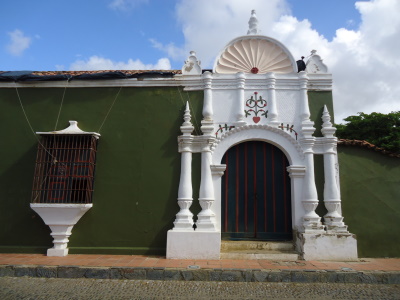Coro and its Port

Coro and its Port comprise an urban colonial landscape renowned for its earthen architecture that is unique in the Caribbean.
The city of Santa Ana de Coro was founded in 1527 in the early days of Spanish colonization. It has conserved its original layout and early urban landscape very well. The buildings show examples of traditional mud-building techniques, which are still being used. The architecture is a unique fusion of Mudejar, native, Spanish and Dutch influences, the latter through the neighbouring islands of Curaçao and Aruba.
Community Perspective: the only reviewer so far, Joseph, details a visit from 2009.
Map of Coro and its Port
Load mapCommunity Reviews
Alejandro Lau

(Visited 2024.10)
In these years Venezuela seems to be a bit "removed" from the plan of international tourists. After an overnight bus from Caracas we arrived at Coro in early morning. We had some empanadas as our breakfast near the terminal, which is fair and delicious.
After the breakfast we walk ~15 min to the WHS area. San Francisco church is the most important building of this WHS and it would be your first impression. It was open when we arrived so we can enjoy the church without any problem. After we headed to Casa Balcón de los Arcaya, which opened later at 8. The house now houses a little museum but it's not that interesting. However the balcony did impress us a lot thus we took a lot of photos. In the morning of Saturday there's almost nobody on the street, only a few local residents were walking along. With this atmosphere we visited almost all WHS area. But unfortunately almost all museums are closed on weekends. (incl. the synagogue and Casa de Las Ventanas de Hierro)
Later after 10 the city started its activities, we settled down and had a short break at our accomodation. During the noon the temperature becomes red-hot so we decided to go to the Médanos later at 4. The park is not well-maintained now, but you can tell it was once full of visitors.
The follwed day we took the bus to Vela (its port). The buses shows "Velita" on their windows. You can catch them anywhere along the Av. Buchivacoa-Pinto Salinas-Independencia and it was 20 bolivares.
Vela preserves more old houses than the Casco Viejo and it was also quiet during the day. The custom house is a must-see. Now it works as acultural center but it's usually closed. We were lucky enough to meet some choir members who was practising so that we were able to enter. To be honest it doesn't have much to see. We spent ~1.5 hours there just walking around and taking photos and later we went back to Coro and left for Maracaibo.
Compared with other historical centers of Latin America, Coro is not that outstanding. But we enjoyed the atmosphere of its locality. Probably because it's not tourist-oriented: you won't see any hawkers or souvenir shops there. So, slow down your step and dive into the pure ancient vibe.
Joseph Colletti
I visited Coro in August 2009. I think the historical significance of the site is probably the main reason for its inclusion on the list, rather than any significant colonial architecture. As the part of the city that shows off the colonial past is quite small, no more than nine or ten square blocks, even with visits to the museums most visitors will probably need no more than a few hours, half a day at most, to get a sense of the city and stroll the most interesting streets and plazas and get something to eat.
Unfortunately there are not too many other places in Venezuela that retain their colonial sections at all, and certainly not with such a architectural integrity and cleanliness. Those places that do often have changes to the facades,adapted residences for other uses such as restaurants and shops, spider webs of electric lines, abandoned buildings, cracked and pot hole filled streets and piles of garbage. The cleanliness alone of Coro is enough to recommend it. (I could not help comparing it to the much larger and more dramatic setting overlooking the Orinoco of the colonial section of Ciudad Bolivar, which, unfortunately has suffered from the ravages of time, poor planning and, in many places, its use as an open garbage dump and latrine.)
I noticed the site is on the endangered list and obviously much has been done and is being done to restore and repair the colonial section and the plazas. Many of the buildings looked newly painted. Several of the churches and museums were closed for renovations and strolling should be left to the early morning or evening as the heat of the day can be quite oppressive. Coro is easily reachable by bus from nearby cities. The surroundings of Coro, including the sand dunes (be careful, I heard several reports of robberies in that area) and the Paraguana peninsula are worth a visit if in the area.
Community Rating
Site Info
Site History
2005 In Danger
Deep concern over gradual and considerable deterioration in the state of conservation
1993 Name change
Changed at inscription from "Coro and its dunes"
1993 Advisory Body overruled
Referral was advised
1993 Revision
Nomination also included Coro Dunes National Park, which was not inscribed
1993 Inscribed
Site Links
Unesco Website
Official Website
Related
In the News
Connections
The site has 17 connections
Art and Architecture
Constructions
Geography
Human Activity
Religion and Belief
Timeline
Trivia
WHS Names
WHS on Other Lists
World Heritage Process
Visitors
27 Community Members have visited.
The Plaque
No plaque has been identified yet for this site.